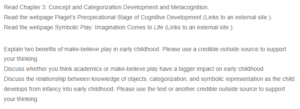Make Play Believe
Piaget’s preoperational stage of cognitive development starts at age 2-6 and entails symbolic thought (language and imagination). However, he claims that operational and logical Piaget is impossible (Babakr, Mohamedamin, & Kakamad, 2019). Make-believe play is the act of thinking of an imaginary world and pretending to live in it as animals, fairies, or people or the capability of kids to use activities, ideas, or objects to characterize other actions, objects, or thoughts while playing (BabySparks, 2017). Before make-believe or symbolic play, a block to a child remains a block, but after, the block can be a phone or car.
Do you need help with your assignment ? Get in touch with us at eminenecepapers.com.
Symbolic play or make-believe is fundamental in early childhood because it helps nurture social-emotional abilities. For instance, a dinner party presenting dolls, conversing, and sharing food can improve a child’s understanding of social communication. Secondly, it lays a foundation for future writing, maths, and reading achievement. Numbers, equations, words, and letters represent symbols. Make-believe play is often a child’s first involvement using symbols; children can use symbols to solve issues and mean different things (BabySparks, 2017).
Make-believe play impacts early childhood more than academics because it builds executive function, supports language abilities, boosts creativity, and nurtures social-emotional skills vital for proper and successful learning (BODROVA, 2020). As such, make-believe play remains more important than academics because it helps prepare the child’s brain and knowledge so that it is easy to introduce learners to learning and excelling in future studies.
Symbolic play in a child develops from 18-20 months. Before 18 months, children’s play is founded on imitation and exploration. As this phase ends, a child can emulate a perceived action; therefore, children have some knowledge of objects as they can try putting a toy in their mouth. A cognitive shift happens at 18-24 months because the child starts understanding that one object can represent a different thing, which infers categorization. For instance, a stone in the yard can be a car a child plays with or pushes. Children can start playing with dolls or stuffed animals as real things. For instance, a child can feed a doll using a spoon. At around 24 months, a child enters the symbolic representation stage and engages in extended play because they start acting out of sequences. For instance, before laying the doll to bed, the doll is fed dinner, and the face is cleaned (BabySparks, 2017). This sequence gets more sophisticated as they move to age three. This stage evolves and gets increasingly complicated throughout childhood.
References
Babakr, Z., Mohamedamin, P., & Kakamad, K. (2019). Piaget’s cognitive developmental theory: Critical review. Education Quarterly Reviews, 2(3).
BabySparks. (2017). Symbolic Play: Imagination Comes to Life. Babysparks.com. Retrieved 12 September 2022, from https://babysparks.com/2017/04/28/symbolic-play-imagination-comes-to-life/#:~:text=Symbolic%20play%20supports%20language%20skills,play%20kitchen20sets%2C%20and%20costumes.
BODROVA, E. (2020). CHAPTER ELEVEN MAKE-BELIEVE PLAY VS. ACADEMIC SKILLS: A VYGOTSKIAN APPROACH TO TODAY’S DILEMMA. Early Childhood Programs as the Doorway to Social Cohesion: Application of Vygotsky’s Ideas from an East-West Perspective, 161.
ORDER A PLAGIARISM-FREE PAPER HERE
We’ll write everything from scratch
Question
Read Chapter 3: Concept and Categorization Development and Metacognition.
Read the webpage Piaget’s Preoperational Stage of Cognitive Development (Links to an external site.).
Read the webpage Symbolic Play: Imagination Comes to Life (Links to an external site.).

Make Play Believe
Explain two benefits of make-believe play in early childhood. Please use a credible outside source to support your thinking.
Discuss whether you think academics or make-believe play have a bigger impact on early childhood.
Discuss the relationship between knowledge of objects, categorization, and symbolic representation as the child develops from infancy into early childhood. Please use the text or another credible outside source to support your thinking.


